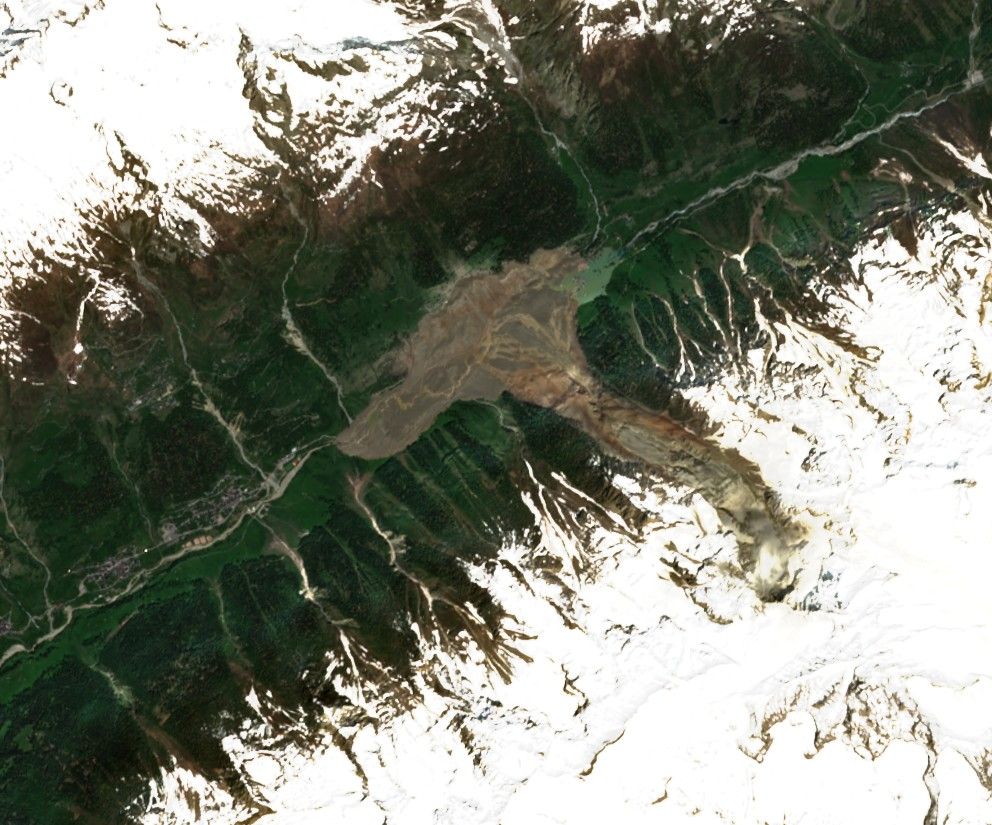
Landslide in Blatten, Switzerland: A Satellite Imagery Analysis
On May 28, 2025, the serene alpine village of Blatten in Switzerland’s Lötschental Valley was obliterated by a catastrophic landslide triggered by a collapsing Birch Glacier. Iconic wooden chalets, part of the UNESCO-listed Jungfrau-Aletsch region, were reduced to rubble, and flooding from a blocked river compounded the disaster. As climate change accelerates glacial melting, Blatten’s destruction serves as a grim warning of the Alps’ vulnerability.
Swiss Alpine Village Blatten Devastated by Glacier Landslide
On Wednesday afternoon, May 28, a dramatic natural disaster unfolded in the heart of the Swiss Alps. A massive chunk of the Birch Glacier detached, unleashing a powerful landslide that buried the majority of the UNESCO-protected village of Blatten, located in the Lötschental Valley in the canton of Valais.
According to emergency services, around 90% of Blatten has been destroyed or covered by debris. The village’s iconic wooden Alpine houses now lie in ruins beneath tons of mud and rock. Local authorities had preemptively evacuated approximately 300 residents on May 19, following warnings from glaciologists about a heightened risk of avalanche due to unseasonal melting.
Search and Rescue Hampered by Terrain Instability
Rescue teams had been searching for a missing 64-year-old man believed to have been in the area, but efforts were halted due to unstable ground conditions. Roads leading to the village have been closed, and officials warn that the area remains extremely dangerous.


Blatten, Switzerland – before and after the May 28, 2025 landslide.


View the full satellite imagery report
Satellite Imagery Report: Blatten Disaster Zone
Flood Risk After River Blockage - Military and Helicopters Deployed
The landslide blocked the flow of the nearby Lonza River, creating an artificial lake that has grown rapidly, rising at a rate of 80 centimeters per hour. Buildings in Blatten that escaped the initial destruction are now submerged in floodwater. Evacuations have been extended to nearby villages as a precaution.
The Swiss military has been deployed to assist with the crisis. On Thursday, helicopters were used to evacuate farm animals trapped in the disaster zone. Despite efforts, authorities note that the response remains challenging due to hazardous conditions and continued landslide risks.
Heritage Village Nearly Lost
Blatten is part of the Jungfrau-Aletsch area, a designated UNESCO World Heritage Site known for its natural beauty and cultural significance.
Stephane Ganzer, head of regional safety services, confirmed that the village had suffered near-total devastation. Swiss federal and cantonal authorities have pledged support and emergency funding for displaced residents, although a timeline for safe return remains unclear.
Visual Evidence: Satellite Images Reveal Full Scale of Destruction
The true magnitude of the disaster in Blatten becomes starkly evident when viewed from space. High-resolution satellite imagery captured before and after the landslide provides a haunting visual narrative of what was lost. In pre-disaster images, Blatten is seen nestled peacefully in the lush green Lötschental Valley, with its traditional wooden chalets aligned along winding alpine paths.
Post-disaster images, however, show an entirely different landscape: a vast scar of gray and brown debris where most of the village once stood. The once-defined streets and homes are now indistinct beneath a thick layer of mud and rock. Roofs have disappeared, buildings are flattened, and the formerly flowing Lonza River is visibly dammed by natural obstructions, forming an artificial lake that continues to grow.
These satellite photos—have been instrumental in both assessing the damage and planning emergency response. They also serve a broader purpose: they are a powerful visual testimony of the fragility of mountain communities in the face of accelerating climate change.
Experts say such imagery is not only valuable for documentation, but for early-warning systems as well. In the future, frequent satellite monitoring may help prevent such tragedies—or at least offer more time for evacuation.
Climate Change and Melting Glaciers
The catastrophe in Blatten underscores the growing threat of climate change in the Alps. Switzerland, home to more glaciers than any other European country, has seen accelerated glacial retreat in recent years. In 2023, Swiss glaciers lost 4% of their total volume, the second-largest annual decline after a 6% loss in 2022. Glaciologists attribute this rapid melting to global warming, which is also destabilizing permafrost and increasing the risk of landslides. Experts warn that without limiting global temperature rise to 1.5°C above pre-industrial levels, Switzerland’s glaciers could vanish within a century, endangering more alpine communities.
Blatten is not the first village to face such a fate. In 2023, the village of Brienz in eastern Switzerland was evacuated due to a sliding mountainside, with residents allowed only brief returns. In 2017, a massive landslide near Bondo claimed eight lives and destroyed numerous homes, marking one of the worst such disasters in over a century.
A Warning for the Future
This tragedy underscores the increasing risks Alpine communities face due to global warming. Without decisive climate action, scientists warn that many of Switzerland’s glaciers could disappear within a century, and more villages may be forced to evacuate.
Related articles
- Biebrza National Park Fire: Destruction & Recovery Efforts
- South Korea Wildfires: Satellite Images Reveal the Damage
- Essential Tips for Interpreting Satellite Imagery Like a Pro
- Using Satellite Imagery As Evidence In Judicial Proceedings
- How Satellite Imagery Improves Crisis Management and Disaster Response